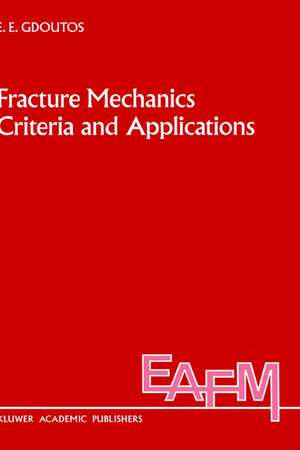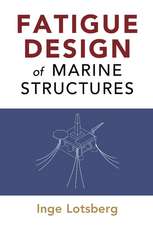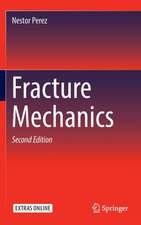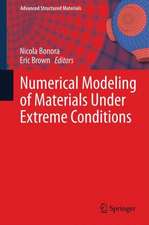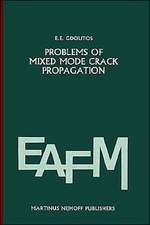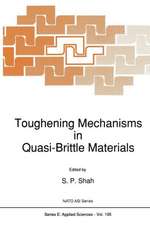Fracture Mechanics Criteria and Applications: Engineering Applications of Fracture Mechanics, cartea 10
Autor E.E. Gdoutosen Limba Engleză Hardback – 30 noi 1990
| Toate formatele și edițiile | Preț | Express |
|---|---|---|
| Paperback (1) | 946.24 lei 6-8 săpt. | |
| SPRINGER NETHERLANDS – 27 sep 2011 | 946.24 lei 6-8 săpt. | |
| Hardback (1) | 952.26 lei 6-8 săpt. | |
| SPRINGER NETHERLANDS – 30 noi 1990 | 952.26 lei 6-8 săpt. |
Preț: 952.26 lei
Preț vechi: 1161.29 lei
-18% Nou
Puncte Express: 1428
Preț estimativ în valută:
182.21€ • 189.87$ • 150.87£
182.21€ • 189.87$ • 150.87£
Carte tipărită la comandă
Livrare economică 03-17 aprilie
Preluare comenzi: 021 569.72.76
Specificații
ISBN-13: 9780792306054
ISBN-10: 0792306058
Pagini: 314
Ilustrații: XIV, 314 p.
Dimensiuni: 156 x 234 x 19 mm
Greutate: 0.64 kg
Ediția:1990
Editura: SPRINGER NETHERLANDS
Colecția Springer
Seria Engineering Applications of Fracture Mechanics
Locul publicării:Dordrecht, Netherlands
ISBN-10: 0792306058
Pagini: 314
Ilustrații: XIV, 314 p.
Dimensiuni: 156 x 234 x 19 mm
Greutate: 0.64 kg
Ediția:1990
Editura: SPRINGER NETHERLANDS
Colecția Springer
Seria Engineering Applications of Fracture Mechanics
Locul publicării:Dordrecht, Netherlands
Public țintă
ResearchCuprins
1. Introductory chapter.- 1.1. Conventional failure criteria.- 1.2. Characteristic brittle failures.- 1.3. Griffith’s work.- 1.4. Fracture mechanics.- References.- 2. Linear elastic stress field in cracked bodies.- 2.1. Introduction.- 2.2. Crack deformation modes and basic concepts.- 2.3. Eigenfunction expansion method for a semi-infinite crack.- 2.4. Westergaard method.- 2.5. Singular stress and displacement fields.- 2.6. Method of complex potentials.- 2.7. Numerical methods.- 2.8. Experimental methods.- 2.9. Three-dimensional crack problems.- 2.10. Cracks in bending plates and shells.- References.- 3. Elastic-plastic stress field in cracked bodies.- 3.1. Introduction.- 3.2. Approximate determination of the crack-tip plastic zone.- 3.3. Small-scale yielding solution for antiplane mode.- 3.4. Complete solution for antiplane mode.- 3.5. Irwin’s model.- 3.6. Dugdale’s model.- 3.7. Singular solution for a work-hardening material.- 3.8. Numerical solutions.- References.- 4. Crack growth based on energy balance.- 4.1. Introduction.- 4.2. Energy balance during crack growth.- 4.3. Griffith theory.- 4.4. Graphical representation of the energy balance equation.- 4.5. Equivalence between strain energy release rate and stress intensity factor.- 4.6. Compliance.- 4.7. Critical stress intensity factor fracture criterion.- 4.8. Experimental determination of KIc.- 4.9. Crack stability.- 4.10. Crack growth resistance curve (R-curve) method.- 4.11. Mixed-mode crack propagation.- References.- 5. J-Integral and crack opening displacement fracture criteria.- 5.1. Introduction.- 5.2. Path-independent integrals.- 5.3. J-integral.- 5.4. Relationship between the J-integral and potential energy.- 5.5. J-integral fracture criterion.- 5.6. Experimental determination of the J-integral.- 5.7.Stable crack growth studied by the J-integral.- 5.8. Mixed-mode crack growth.- 5.9. Crack opening displacement (COD) fracture criterion.- References.- 6. Strain energy density failure criterion.- 6.1. Introduction.- 6.2. Volume strain energy density.- 6.3. Basic hypotheses.- 6.4. Two-dimensional linear elastic crack problems.- 6.5. Uniaxial extension of an inclined crack.- 6.6. Three-dimensional linear elastic crack problems.- 6.7. Bending of cracked plates.- 6.8. Ductile fracture.- 6.9. Failure initiation in bodies without pre-existing cracks.- 6.10. Other criteria based on energy density.- References.- 7. Dynamic fracture.- 7.1. Introduction.- 7.2. Mott’s model.- 7.3. Stress field around a rapidly propagating crack.- 7.4. Strain energy release rate.- 7.5. Transient response of cracks to impact loads.- 7.6. Standing plane waves interacting with a crack.- 7.7. Crack branching.- 7.8. Crack arrest.- 7.9. Experimental determination of crack velocity and dynamic stress intensity factor.- References.- 8. Fatigue and environment-assisted fracture.- 8.1. Introduction.- 8.2. Fatigue crack propagation laws.- 8.3. Fatigue life calculations.- 8.4. Variable amplitude loading.- 8.5. Mixed-mode fatigue crack propagation.- 8.6. Nonlinear fatigue analysis based on the strain energy density theory.- 8.7. Environment-assisted fracture.- References.- 9. Engineering applications.- 9.1. Introduction.- 9.2. Fracture mechanics design philosophy.- 9.3. Design example problems.- 9.4. Fiber-reinforced composites.- 9.5. Concrete.- 9.6. Crack detection methods.- References.- Author Index.
Recenzii
' The book is recommended for engineers and research workers interested in modern mechanics of materials...In addition, there is a very rich and up-to-date collection of references that is very useful for readers wishing to improve their knowledge of any specific topic in fracture mechanics.' Meccanica 27:143-145 1992
